2009 CHEVROLET CORVETTE oil temperature
[x] Cancel search: oil temperaturePage 259 of 434
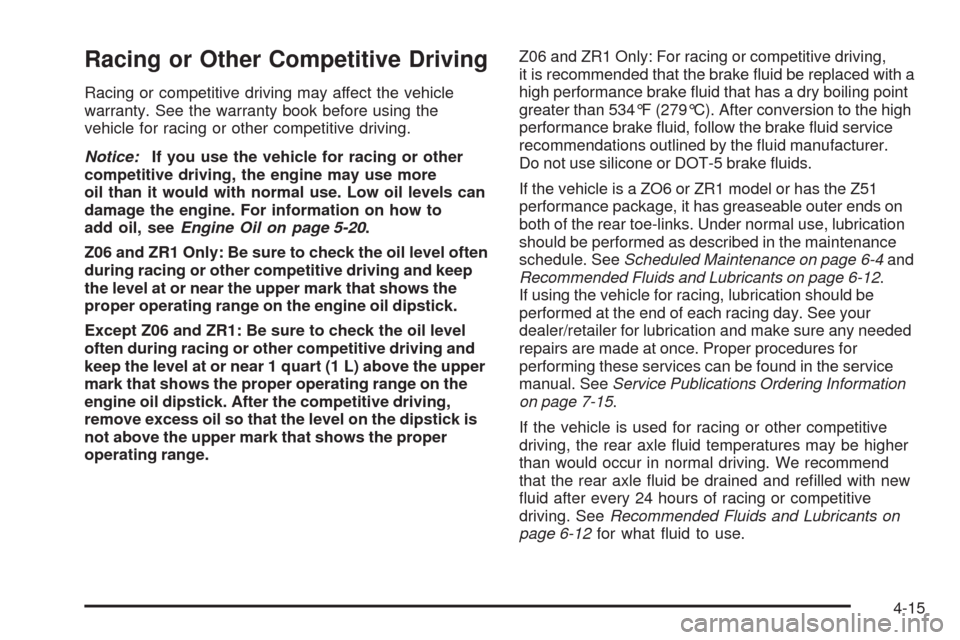
Racing or Other Competitive Driving
Racing or competitive driving may affect the vehicle
warranty. See the warranty book before using the
vehicle for racing or other competitive driving.
Notice:If you use the vehicle for racing or other
competitive driving, the engine may use more
oil than it would with normal use. Low oil levels can
damage the engine. For information on how to
add oil, seeEngine Oil on page 5-20.
Z06 and ZR1 Only: Be sure to check the oil level often
during racing or other competitive driving and keep
the level at or near the upper mark that shows the
proper operating range on the engine oil dipstick.
Except Z06 and ZR1: Be sure to check the oil level
often during racing or other competitive driving and
keep the level at or near 1 quart (1 L) above the upper
mark that shows the proper operating range on the
engine oil dipstick. After the competitive driving,
remove excess oil so that the level on the dipstick is
not above the upper mark that shows the proper
operating range.Z06 and ZR1 Only: For racing or competitive driving,
it is recommended that the brake �uid be replaced with a
high performance brake �uid that has a dry boiling point
greater than 534°F (279°C). After conversion to the high
performance brake �uid, follow the brake �uid service
recommendations outlined by the �uid manufacturer.
Do not use silicone or DOT-5 brake �uids.
If the vehicle is a ZO6 or ZR1 model or has the Z51
performance package, it has greaseable outer ends on
both of the rear toe-links. Under normal use, lubrication
should be performed as described in the maintenance
schedule. SeeScheduled Maintenance on page 6-4and
Recommended Fluids and Lubricants on page 6-12.
If using the vehicle for racing, lubrication should be
performed at the end of each racing day. See your
dealer/retailer for lubrication and make sure any needed
repairs are made at once. Proper procedures for
performing these services can be found in the service
manual. SeeService Publications Ordering Information
on page 7-15.
If the vehicle is used for racing or other competitive
driving, the rear axle �uid temperatures may be higher
than would occur in normal driving. We recommend
that the rear axle �uid be drained and re�lled with new
�uid after every 24 hours of racing or competitive
driving. SeeRecommended Fluids and Lubricants on
page 6-12for what �uid to use.
4-15
Page 294 of 434
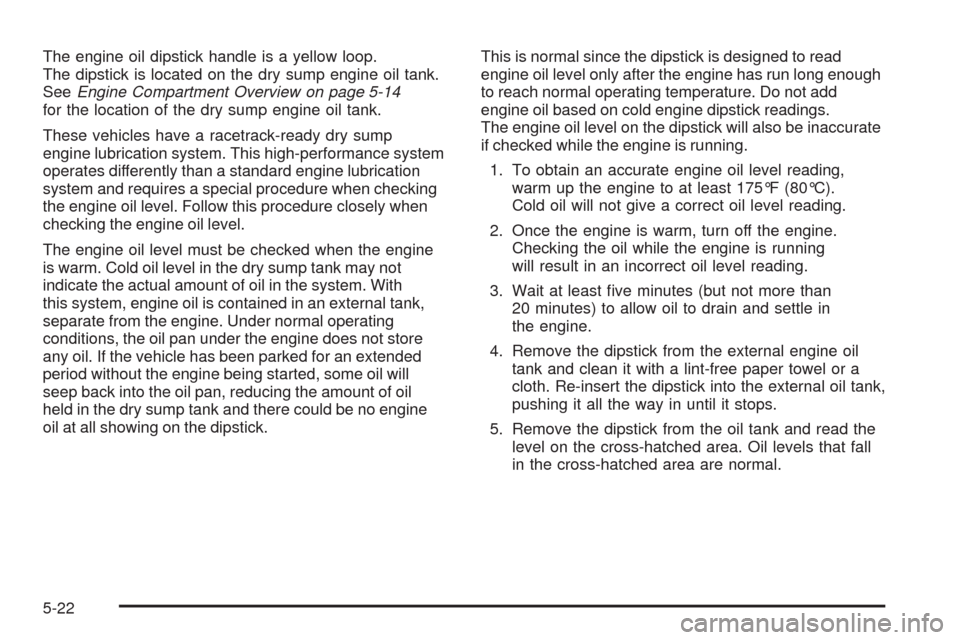
The engine oil dipstick handle is a yellow loop.
The dipstick is located on the dry sump engine oil tank.
SeeEngine Compartment Overview on page 5-14
for the location of the dry sump engine oil tank.
These vehicles have a racetrack-ready dry sump
engine lubrication system. This high-performance system
operates differently than a standard engine lubrication
system and requires a special procedure when checking
the engine oil level. Follow this procedure closely when
checking the engine oil level.
The engine oil level must be checked when the engine
is warm. Cold oil level in the dry sump tank may not
indicate the actual amount of oil in the system. With
this system, engine oil is contained in an external tank,
separate from the engine. Under normal operating
conditions, the oil pan under the engine does not store
any oil. If the vehicle has been parked for an extended
period without the engine being started, some oil will
seep back into the oil pan, reducing the amount of oil
held in the dry sump tank and there could be no engine
oil at all showing on the dipstick.This is normal since the dipstick is designed to read
engine oil level only after the engine has run long enough
to reach normal operating temperature. Do not add
engine oil based on cold engine dipstick readings.
The engine oil level on the dipstick will also be inaccurate
if checked while the engine is running.
1. To obtain an accurate engine oil level reading,
warm up the engine to at least 175°F (80°C).
Cold oil will not give a correct oil level reading.
2. Once the engine is warm, turn off the engine.
Checking the oil while the engine is running
will result in an incorrect oil level reading.
3. Wait at least �ve minutes (but not more than
20 minutes) to allow oil to drain and settle in
the engine.
4. Remove the dipstick from the external engine oil
tank and clean it with a lint-free paper towel or a
cloth. Re-insert the dipstick into the external oil tank,
pushing it all the way in until it stops.
5. Remove the dipstick from the oil tank and read the
level on the cross-hatched area. Oil levels that fall
in the cross-hatched area are normal.
5-22
Page 297 of 434
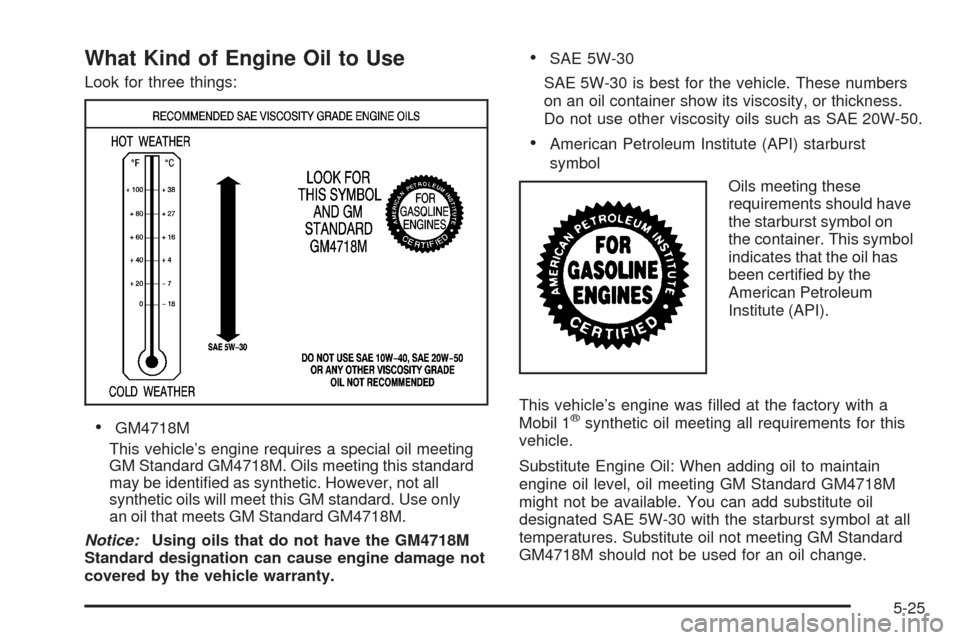
What Kind of Engine Oil to Use
Look for three things:
GM4718M
This vehicle’s engine requires a special oil meeting
GM Standard GM4718M. Oils meeting this standard
may be identi�ed as synthetic. However, not all
synthetic oils will meet this GM standard. Use only
an oil that meets GM Standard GM4718M.
Notice:Using oils that do not have the GM4718M
Standard designation can cause engine damage not
covered by the vehicle warranty.
SAE 5W-30
SAE 5W-30 is best for the vehicle. These numbers
on an oil container show its viscosity, or thickness.
Do not use other viscosity oils such as SAE 20W-50.
American Petroleum Institute (API) starburst
symbol
Oils meeting these
requirements should have
the starburst symbol on
the container. This symbol
indicates that the oil has
been certi�ed by the
American Petroleum
Institute (API).
This vehicle’s engine was �lled at the factory with a
Mobil 1
®synthetic oil meeting all requirements for this
vehicle.
Substitute Engine Oil: When adding oil to maintain
engine oil level, oil meeting GM Standard GM4718M
might not be available. You can add substitute oil
designated SAE 5W-30 with the starburst symbol at all
temperatures. Substitute oil not meeting GM Standard
GM4718M should not be used for an oil change.
5-25
Page 298 of 434
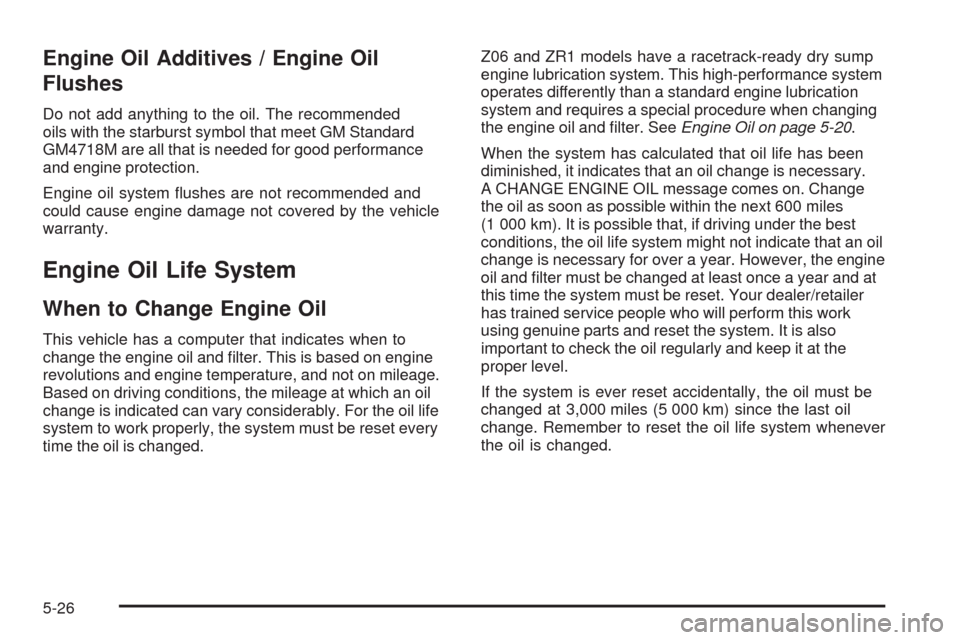
Engine Oil Additives / Engine Oil
Flushes
Do not add anything to the oil. The recommended
oils with the starburst symbol that meet GM Standard
GM4718M are all that is needed for good performance
and engine protection.
Engine oil system �ushes are not recommended and
could cause engine damage not covered by the vehicle
warranty.
Engine Oil Life System
When to Change Engine Oil
This vehicle has a computer that indicates when to
change the engine oil and �lter. This is based on engine
revolutions and engine temperature, and not on mileage.
Based on driving conditions, the mileage at which an oil
change is indicated can vary considerably. For the oil life
system to work properly, the system must be reset every
time the oil is changed.Z06 and ZR1 models have a racetrack-ready dry sump
engine lubrication system. This high-performance system
operates differently than a standard engine lubrication
system and requires a special procedure when changing
the engine oil and �lter. SeeEngine Oil on page 5-20.
When the system has calculated that oil life has been
diminished, it indicates that an oil change is necessary.
A CHANGE ENGINE OIL message comes on. Change
the oil as soon as possible within the next 600 miles
(1 000 km). It is possible that, if driving under the best
conditions, the oil life system might not indicate that an oil
change is necessary for over a year. However, the engine
oil and �lter must be changed at least once a year and at
this time the system must be reset. Your dealer/retailer
has trained service people who will perform this work
using genuine parts and reset the system. It is also
important to check the oil regularly and keep it at the
proper level.
If the system is ever reset accidentally, the oil must be
changed at 3,000 miles (5 000 km) since the last oil
change. Remember to reset the oil life system whenever
the oil is changed.
5-26
Page 307 of 434
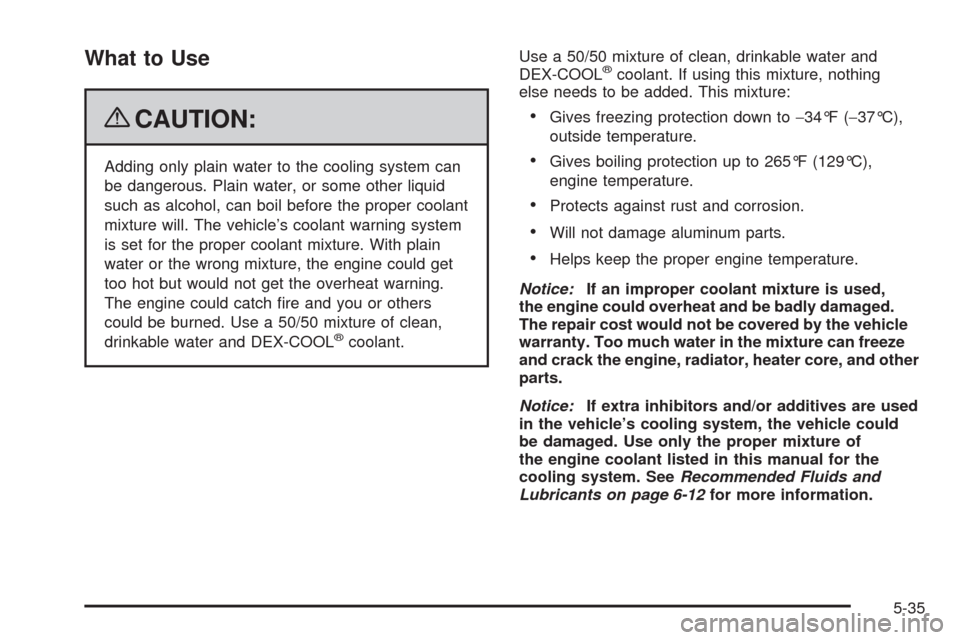
What to Use
{CAUTION:
Adding only plain water to the cooling system can
be dangerous. Plain water, or some other liquid
such as alcohol, can boil before the proper coolant
mixture will. The vehicle’s coolant warning system
is set for the proper coolant mixture. With plain
water or the wrong mixture, the engine could get
too hot but would not get the overheat warning.
The engine could catch �re and you or others
could be burned. Use a 50/50 mixture of clean,
drinkable water and DEX-COOL
®coolant.Use a 50/50 mixture of clean, drinkable water and
DEX-COOL
®coolant. If using this mixture, nothing
else needs to be added. This mixture:
Gives freezing protection down to−34°F (−37°C),
outside temperature.
Gives boiling protection up to 265°F (129°C),
engine temperature.
Protects against rust and corrosion.
Will not damage aluminum parts.
Helps keep the proper engine temperature.
Notice:If an improper coolant mixture is used,
the engine could overheat and be badly damaged.
The repair cost would not be covered by the vehicle
warranty. Too much water in the mixture can freeze
and crack the engine, radiator, heater core, and other
parts.
Notice:If extra inhibitors and/or additives are used
in the vehicle’s cooling system, the vehicle could
be damaged. Use only the proper mixture of
the engine coolant listed in this manual for the
cooling system. SeeRecommended Fluids and
Lubricants on page 6-12for more information.
5-35
Page 313 of 434
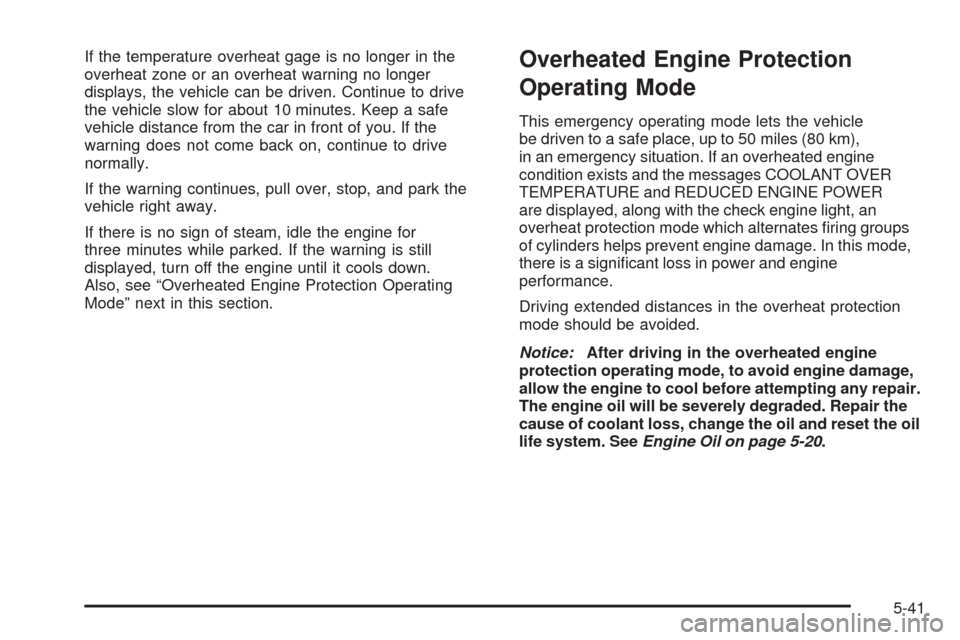
If the temperature overheat gage is no longer in the
overheat zone or an overheat warning no longer
displays, the vehicle can be driven. Continue to drive
the vehicle slow for about 10 minutes. Keep a safe
vehicle distance from the car in front of you. If the
warning does not come back on, continue to drive
normally.
If the warning continues, pull over, stop, and park the
vehicle right away.
If there is no sign of steam, idle the engine for
three minutes while parked. If the warning is still
displayed, turn off the engine until it cools down.
Also, see “Overheated Engine Protection Operating
Mode” next in this section.Overheated Engine Protection
Operating Mode
This emergency operating mode lets the vehicle
be driven to a safe place, up to 50 miles (80 km),
in an emergency situation. If an overheated engine
condition exists and the messages COOLANT OVER
TEMPERATURE and REDUCED ENGINE POWER
are displayed, along with the check engine light, an
overheat protection mode which alternates �ring groups
of cylinders helps prevent engine damage. In this mode,
there is a signi�cant loss in power and engine
performance.
Driving extended distances in the overheat protection
mode should be avoided.
Notice:After driving in the overheated engine
protection operating mode, to avoid engine damage,
allow the engine to cool before attempting any repair.
The engine oil will be severely degraded. Repair the
cause of coolant loss, change the oil and reset the oil
life system. SeeEngine Oil on page 5-20.
5-41
Page 424 of 434
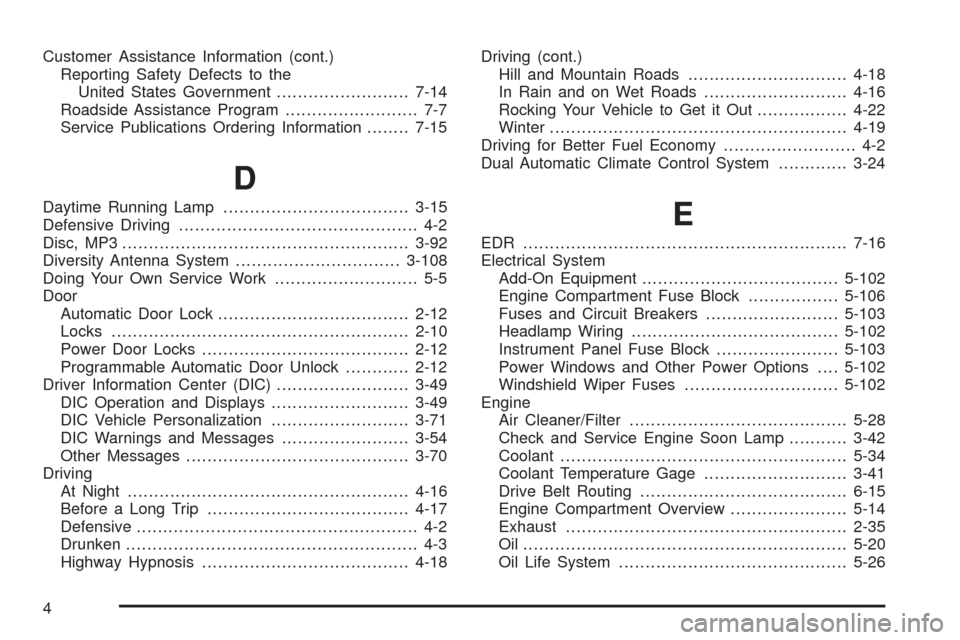
Customer Assistance Information (cont.)
Reporting Safety Defects to the
United States Government.........................7-14
Roadside Assistance Program......................... 7-7
Service Publications Ordering Information........7-15
D
Daytime Running Lamp...................................3-15
Defensive Driving............................................. 4-2
Disc, MP3......................................................3-92
Diversity Antenna System...............................3-108
Doing Your Own Service Work........................... 5-5
Door
Automatic Door Lock....................................2-12
Locks........................................................2-10
Power Door Locks.......................................2-12
Programmable Automatic Door Unlock............2-12
Driver Information Center (DIC).........................3-49
DIC Operation and Displays..........................3-49
DIC Vehicle Personalization..........................3-71
DIC Warnings and Messages........................3-54
Other Messages..........................................3-70
Driving
At Night.....................................................4-16
Before a Long Trip......................................4-17
Defensive..................................................... 4-2
Drunken....................................................... 4-3
Highway Hypnosis.......................................4-18Driving (cont.)
Hill and Mountain Roads..............................4-18
In Rain and on Wet Roads...........................4-16
Rocking Your Vehicle to Get it Out.................4-22
Winter........................................................4-19
Driving for Better Fuel Economy......................... 4-2
Dual Automatic Climate Control System.............3-24E
EDR .............................................................7-16
Electrical System
Add-On Equipment.....................................5-102
Engine Compartment Fuse Block.................5-106
Fuses and Circuit Breakers.........................5-103
Headlamp Wiring.......................................5-102
Instrument Panel Fuse Block.......................5-103
Power Windows and Other Power Options....5-102
Windshield Wiper Fuses.............................5-102
Engine
Air Cleaner/Filter.........................................5-28
Check and Service Engine Soon Lamp...........3-42
Coolant......................................................5-34
Coolant Temperature Gage...........................3-41
Drive Belt Routing.......................................6-15
Engine Compartment Overview......................5-14
Exhaust.....................................................2-35
Oil .............................................................5-20
Oil Life System...........................................5-26
4
Page 425 of 434

Engine (cont.)
Oil Pressure Gage.......................................3-46
Overheated Protection Operating Mode...........5-41
Overheating................................................5-39
Starting......................................................2-23
Entry/Exit Lighting...........................................3-18
Event Data Recorders.....................................7-17
Extender, Safety Belt.......................................1-25
Exterior Lamps...............................................3-14
Exterior Lighting Battery Saver..........................3-17
F
Filter
Engine Air Cleaner......................................5-28
Finish Damage.............................................5-100
Flashers, Hazard Warning.................................. 3-6
Flash-to-Pass................................................... 3-9
Flat Tire........................................................5-90
Floor Mats.....................................................2-51
Fluid
Automatic Transmission................................5-30
Power Steering...........................................5-42
Windshield Washer......................................5-43
Fog Lamp
Fog ...........................................................3-16
Fog Lamp Light..............................................3-47
Front Air Dam................................................2-21Fuel............................................................... 5-6
Additives...................................................... 5-7
California Fuel.............................................. 5-7
Driving for Better Economy............................. 4-2
Filling a Portable Fuel Container....................5-12
Filling the Tank............................................. 5-9
Fuels in Foreign Countries.............................. 5-8
Gage .........................................................3-48
Gasoline Octane........................................... 5-6
Gasoline Speci�cations.................................. 5-6
Fuses
Engine Compartment Fuse Block.................5-106
Fuses and Circuit Breakers.........................5-103
Instrument Panel Fuse Block.......................5-103
Windshield Wiper.......................................5-102
G
Gage
Boost.........................................................3-49
Engine Coolant Temperature.........................3-41
Engine Oil Pressure.....................................3-46
Fuel..........................................................3-48
Speedometer..............................................3-34
Tachometer.................................................3-34
Voltmeter Gage...........................................3-37
Garage Door Opener.......................................2-44
5